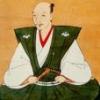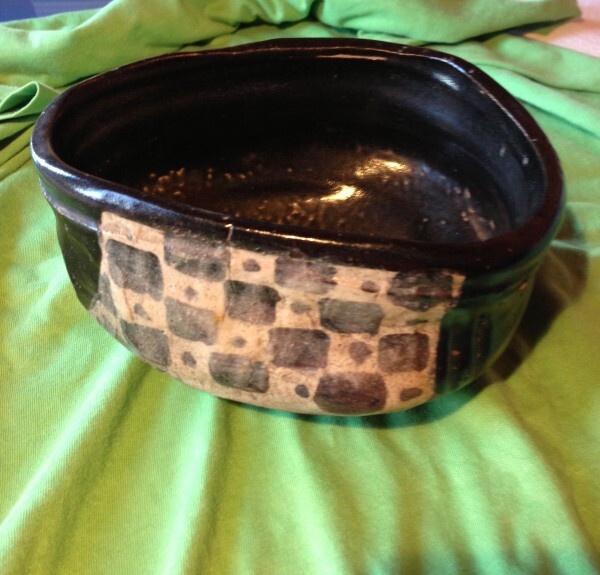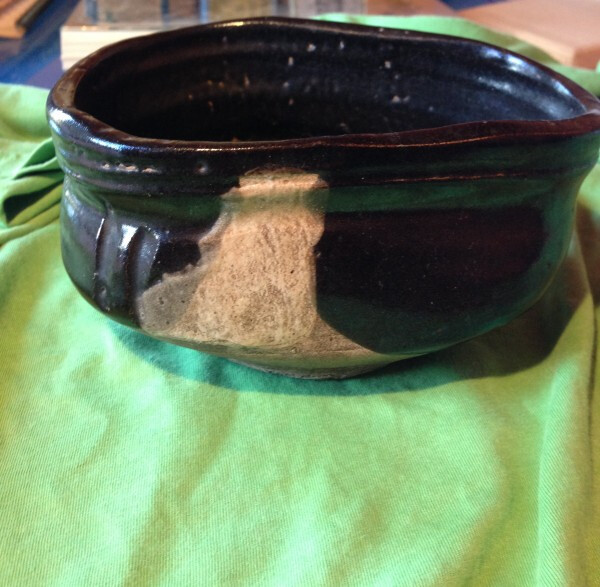-
Posts
964 -
Joined
-
Last visited
-
Days Won
4
Content Type
Profiles
Forums
Events
Store
Downloads
Gallery
Everything posted by Steve Waszak
-
Hi Curran, I believe John is referring to the group of tsuba recovered from the shipwreck of the Spanish vessel, the San Diego, which went down in the middle of the Momoyama Period, around 1600 if I recall correctly... Cheers, Steve
-

Securing a collection in the UK
Steve Waszak replied to Kronos's topic in General Nihonto Related Discussion
I find two or three mastiffs to be a remarkably effective deterrent to thieves. My dogs, plus a fire-resistant safe, is about all I need... Cheers, Steve -
Hi Ed, Many thanks for posting these... All are very appealing. To my eye, and from having studied Momoyama era Oribe ware a bit, the two kogo appear most likely to be period. The chaire is a mayyybe, while the others look revivalist (i.e. 19th-century) or later. The publication, Turning Point: Oribe and the Arts of Sixteenth Century Japan Met Publications, 2003) is an invaluable book for those interested in Momoyama Period pottery, especially that connected with Tea, and even more so as concerns Furuta Oribe and the ware(s) that he is so intimately associated with. In particular, there is a valuable set of images---some of Momoyama era kuro-Oribe pieces, and then of 19th-century revivalist pieces---for comparison purposes. Highly recommended. Cheers, Steve
-
Pete's idea is the way to go. I certainly would be interested in contributing to a translation project for Markus on this book. The problem with having a Japanese person read it for you, Grev, is that unless this person has some good knowledge of the terminology/concepts attached to tsuba study, he or she may have some difficulty in communicating that terminology/those concepts with precision and clarity. Cheers, Steve
-
Hi Ed, Beautiful chawan. Thanks for posting the images. You mentioned Oribe and kuro-Oribe in your post, and having a number of works of these types. Are the pieces you have period (i.e. Momoyama), or later works? Might you have any photos you could share of these? Cheers, Steve
-
Hi Junichi, By "privileged," I am not referencing economic status or a culture of affluence. I am speaking of the term/concept of "art" itself as being of an exalted status, i.e. something termed "real art" versus being seen as "only" craft, or as "only" decoration. Cheers, Steve
-
The real question is why the term "art" is so privileged. To inquire whether a given work is "real art" is to reinforce and sustain "art" as a privileged thing/notion. It may be worth considering what's at stake in the question itself... Cheers, Steve
-
:clap: Well done, Brian. There really is no valid argument against such a forum here on NMB: As Kevin and Thomas say, it is all interrelated. In fact, I would suggest that to study nihonto and tosogu without larger cultural contexts (as may be represented by various other art/craft forms) is likely to yield less convincing conclusions. Thanks for adding this forum, Brian. Cheers, Steve
-
Thanks, Ian. Your thoughts are much appreciated. Cheers, Steve
-
Many thanks for this, Ian. Very helpful, actually. Does it make sense to speculate that, as Sengoku Jidai aggressions wound down over the course of the Momoyama years, "no-name" armorers who showed special skill in finer metal work would (be allowed to) transfer their efforts to tsuba and away from armor production? I guess I'm just wondering what the dynamics were that would see tsubako of the caliber of Yamakichibei and Hoan emerge from the anonymity of armor-making. Both of these smiths are thought to have lived and worked in Kiyosu, Owari (along with Nobuiye). Might there have been some special circumstance that could explain how these guys evolved into tsubako, even tsubako who signed their work (among the very first smiths to sign tsuba)? Just thinking out loud here... Cheers, Steve
-
Great to see so much Iga-yaki here! Brian, it appears we need a ceramics forum... Cheers, Steve P.S. Chris, that Iga tokkuri is especially appealing. Thanks for sharing!
-
This post is really directed at the "armor guys" here... In various reference works, the Momoyama Owari tsubako Yamasaka Kichibei Shigenori and Kawaguchi Saburoemon Noriyasu ("Hoan" is the name he is better known by in tsuba) are mentioned as armorers working for Oda Nobunaga. I'm wondering if any of the armor guys here might have a reference publication which either lists or illustrates an armor or kabuto work by one or both of these smiths. It is unlikely, I realize, but on seeing such mentions of these smiths so specifically as armorers for Nobunaga, I am curious if there might be any publications that note such information. Thanks. Cheers, Steve
-
Brian, Would definitely appreciate a pottery/ceramics category here. As Christian says, some of us are as devoted to yakimono as we are to nihonto/tosogu... Cheers, Steve
-
lol... Sorry, that "yes" was meant as a response to Philip!
-
Yes.
-
Good quiz, Chris... Not wholly confident here, but the anagama "hint" has me leaning toward the first piece (along with a kind of "freedom from prescription" feel to it... ). Looks like a lovely bowl, whether American or Japanese made... I know exactly what you mean about being pulled in so many directions by so many appealing works. I almost have to refrain from looking... But then one can still be waylaid by the lurking fine chawan, as has happened here with the piece presented as the subject of this thread. Cheers, Steve
-
Love the black wares, too... Oribeguro, kuro-Oribe, Setoguro, kuro-Raku... All good. But Iga and Shigaraki are probably #1 and 2 for me as well... Here's a kuro-Oribe chawan I bought in Kamakura way back when... Cheers, Steve
-
I see. Very sorry to hear of his passing as well. Well, it is a great-looking piece, even if the photo is small. Iga is my favorite of the kilns, too... Cheers, Steve
-
Hi Brian, Yes, I tried that, but I don't get that expansion... I just get transferred to the member's info page... But I was hoping, too, that Chris might have other good photos of the mizusashi... Cheers, Steve
-
Chris, That really is a great-looking mizusashi. Do you have any larger photos of it you could/would post? It's hard to tell from the "postage stamp" image if it's period (Momoyama), but it looks to be... Thanks! Cheers, Steve
-
PM sent.
-
Thanks for the link, Chris. Interesting reading, including the comments section at the end. Cheers, Steve
-
Junichi, Much of what you say here express ideas I have long had about the links between Momoyama tetsu tsuba and the dominant Tea Culture those tsuba emerged from and engaged with. The highest of the high-end iron guards of that time I believe were designed via the "guidance" of top buke aesthetes of the day, men whose sensibilities were honed by being steeped (as it were) in Tea. The particular concrete aesthetic details of the major wares of the period are simply too closely echoed in certain tsuba for it to be coincidental, especially given that we can point to specific individuals who would likely, if not definitely, be involved in both. Hosokawa Tadaoki, a Momoyama man even though he becomes Daimyo of Higo in the 1630s, near the end of his life, was a man of Tea (documented) and is credited with essentially establishing the "Big 4" Higo tsuba-making entities (Hirata, Shimizu, Nishigaki, Hayashi). Further, he is thought by some to have inspired/guided the design of some of the tsuba produced in Higo, and is understood even to have made tsuba himself. As far as I'm concerned (and have stated numerous times, now), the link between Tea and certain Momoyama tsuba isn't even questionable. On the Kizaemon Ido bowl, yes, I have long wondered (found dubious) the claim that it was a simple Korean rice bowl. Frankly, it displays a sensibility far too sophisticated---with too many subtle "touches" for a quickly "whipped out" rice bowl. The hypothesis that it is the product of a much loftier aesthetics-driven intent and design is significantly more plausible to me. So the fact that the archeological evidence has resulted in a "surprising" dearth of such bowls or their shards is actually far from surprising to me... Two statements in your post caught my attention, though, Junichi: 1. You say that it "...would also be a bit unfair to compare the aesthetics of late edo kinko tsuba to momoyama tetsu tsuba." Why would this be "unfair"? Unfair how? 2. You say, too that Oribe ware is "...more linked to a style than to a particular kiln or 'school'," but my understanding is that Oribe ware is certainly a type of Mino ware, and that the overwhelming number of Momoyama Period pieces (or remnants thereof) come from a small handful of Mino province kilns. Could you clarify this statement, please? Finally, you say at the end of your post that there may be "other similarities between where the understanding of chawan was up until the 1980s and where with are with tsuba understanding today." I think this is a fair statement, but in using the word "understanding," this does not necessarily sustain the endeavor of classification, right? I'm all for understanding, but remain a bit dubious about attempts to classify these things... Cheers, Steve
-
Hi Brian, Just thinking about what you say here about linking mon to important personages... I can think of a few examples, actually, where the association (as found in tosogu, anyway) is pretty compelling. The first that come to mind are those tsuba presenting with the mon of the Hosokawa made by the Higo tsubako who worked directly for the Hosokawa, and even directly for Hosokawa Sansai. There are many examples, especially of tsuba made by Kanshiro Nishigaki. Then there are pieces which, while not necessarily depicting a mon definitively linked to a specific individual, do use motifs which can, with some degree of confidence, point to an association with a particular lord or clan. I do agree with you that certain mon, because they were used for so long and by so many different families, become dead ends with regard to connecting their use in a given work to a specific person, and that this, mostly likely, is the rule, rather than the exception. Cheers, Steve
-
Well, Chris has stolen my thunder pretty effectively here... I might only emphasize the specific architectural ethos and "pathos" expressed in the tea cottages of Momoyama times as being another manifestation of the particular aesthetic principles informing and/or surrounding Tea. These cottages were significant architectural departures in some ways from the various structures associated with upper-class life (including Buddhist temples and Shinto shrines) of that period, and again, we may see the departures here echoing specfic aesthetic details in Kanayama tsuba (Chris' post notes many of these very well). I would add, too, that certain media lend themselves especially well to the emulating or otherwise expressing of the aesthetics of Tea vessels of the time. David, you'd mentioned saddles and "pajamas," but such media wouldn't be as suitable to the expressing of sabi, yugen, wabi, shibusa, and other aesthetic principles/values as iron likely would be. Thus, tea kettles, ceramics, tsuba, stone lanterns, and the like work well for this aesthetic but other media may not. There is much more that might be said here, too, concerning the likely semiotic function of tsuba (and Tea, of course) among the Buke of the period, but I recall a thread from some time ago already indulging in that, so I won't risk redundancy here... Cheers, Steve





